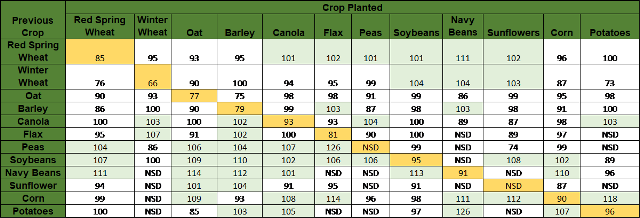Crop Choice Considerations In A Delayed Year
Weather has a way of changing the best-laid plans. In a late spring or with excessive moisture, land will be seeded as it dries and the crops seeded may change from what was on paper a month ago. Factors such as commodity prices, production contracts, ability to control weeds and volunteers, disease potential, as well as crop species ability to withstand water needs to be considered.
Once you can get on the land and seed, you may have concerns about what to plant in case the remainder of the crop season is cool/wet and about the ability of your intended crop to perform.
Crop Choices That Use And Withstand Water
Generally, the longer the season, the more water the crop can use (e.g. winter wheat will use more water than spring wheat). Using crops in the rotation that have a greater ability to use water in-season can help reduce excess soil moisture in the longer-term. Within annual crop options, oilseed crops tend to have greater water use than cereals or pulses. If incorporating perennial crops into the rotation, alfalfa has a deep rooting system and can double the reduction of soil water content compared to continuous annual crops.
In-season, some individual crop species handle soil water better than others (Table 1). For example, faba beans and soybeans are better suited than dry edible beans and peas. Oats tolerate wet soils better than wheat, barley; flax better than canola and sunflower better than corn. If salinity is a concern, barley may be a good choice in a single year, but a salt-tolerant forage would be a better long-term choice.
Table 1: Relative crop suitability under imperfectly drained soils as summarized by texture
| Crop Type | Soil Texture | ||
|---|---|---|---|
| Coarse (Sand) |
Medium (Loam, Clay Loam) |
Fine (Clay) | |
| Soybean | S* | S | S |
| Field Bean | S* | ||
| Faba Bean | S | S | S |
| Pea | S | S | |
| Lentil | S | S | |
| Corn | S | S | |
| Canola | S* | S | S |
| Flax | S* | S | S |
| Wheat | S | S | |
| Oat | S | S | |
| Sunflower | S | S | S |
| Barley | S | S | |
| Alfalfa | S | S | |
*Suitable in wet years, moisture challenges in dry years
Source: Bedard-Haughn, A. 2009. Managing excess water in Canadian prairie soils: A review. Can. J. Soil Sci. 89: 157-168
Crop Rotation Reminders
Crop planted on same crop stubble is not a wise choice under any situation (Table 2). With making this choice, there is an automatic yield penalty mostly due to disease, lack of fertility, insect pressures, etc. For example, canola on canola results in 20% less yield compared to canola planted on spring wheat stubble and spring wheat yields 15% higher when planted on canola stubble versus spring wheat stubble.
Other yield limiting rotations are sunflower on canola stubble due to the sclerotinia infection; flax and corn yields can also suffer when grown on canola stubble due to a lack of a good soil fungi, called mycorrhizae. Corn and flax are hosts for mycorrhizae and work in symbiosis with the fungi for uptake of immobile nutrients, such as phosphorus (P). If the mycorrhizae are present in good populations when the corn and flax are establishing, it enhances P uptake in the season and helps contribute to overall yields. In corn, up to 80% of early season P uptake is by mycorrhizae. Canola is not a host for mycorrhizae, so the fungi must re-grow from spores resulting in early season P deficiency. Corn and flax will often recover later in the growing season but the damage to yield is already done by lack of P early in the growing season.
Table 2: Yield response (of 2011-2020 average) of Manitoba crops sown on large (>120 acre) fields of various previous crops (stubble) in rotation.

Source: Manitoba Agricultural Services Corporation Harvested Acreage Reports 2011-2020.
Crop Maturity Considerations
As the season becomes later, variety maturity and fall frost will become a concern. Calculate backwards from the first potential frost date for your area to your seeding date and determine if the maturity of your variety is still going to work. For maturity information, visit Seed Manitoba at http://www.seedmb.ca/. It is important for farmers to keep in mind that Manitoba Agricultural Services Corporation (MASC) has seeding deadlines that must be met in order to be eligible for crop insurance coverage. To view seeding deadlines, please refer to MASC's website at http://www.masc.mb.ca/masc.nsf/crop_seeding_deadlines.html. It is important to note that these seeding deadlines are generally considered the 'outside' dates for successful crop production.
